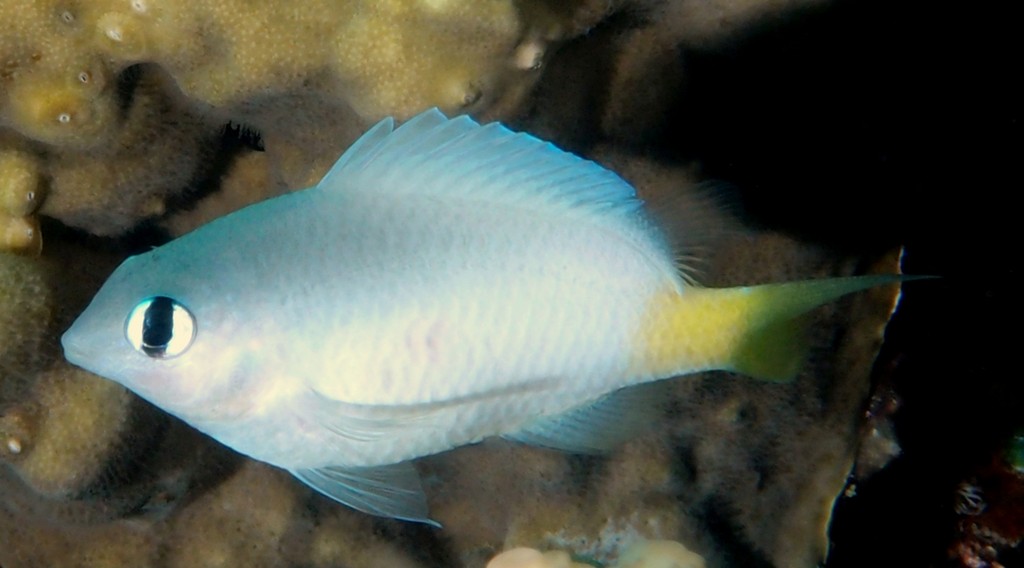PLECTROGLYPHIDODON IMPARIPENNIS - (VAILLANT & SAUVAGE, 1875)
Actinopterygii (Gigaclass) > Actinopteri (Class) > Teleostei (Subclass) > Blenniiformes (Order) > Pomacentridae (Family) > Microspathodontinae (Subfamily) > Plectroglyphidodon (Genus)
Demoiselle à l'Œil Brillant, Brighteye Damsel, Brighteye damselfish, Bright-eye Damsel, Cat's-eye Damsel, Stop-start Damsel, Stop-stat-nooientjie, Gelbbürzel-Riffbarsch, Iwasaki-suzumedai, イワサキスズメダイ, 羽状椒雀鲷, 明眸固曲齿鲷, 普勞氏金翅雀鯛,
Synonymes
Abudefduf imparipennis (Vaillant & Sauvage, 1875)
Abudefduf iwasakii (Okada & Ikeda, 1939)
Chromis elaphrus (Jenkins, 1903)
Chrysiptera prughi (Fowler, 1946)
Glyphisodon imparipennis (Vaillant & Sauvage, 1875)
Oliglyphisodon caeruleomaculatus (Fowler, 1946)
---------------------------------------------
Description
Dorsal spines (total): 12; Dorsal soft rays (total): 14-15; Anal spines: 2; Anal soft rays: 11-12; Pectoral rays: 20; Lateral-line scales 19; Gill rakers: 10-12; Body depth: 2.1-2.4 SL. Margins of preopercle an suborbital smooth. Suborbital scaled. Teeth uniserial. Max length: 6.0 cm TL. Depth range: 0 - 15 m, usually: 0.5 - 3 m.
Color
Body Overall light grey, caudal peduncle and fin often yellow. A black vertical streak across middle of eye. Iris silvery.
Etymology
Plectroglyphidodon: from Greek, plektron = anything to strike with, spur + from Greek, glyphis = carved + from Greek, odous = teeth.
imparipennis: from Latin, impār, imparis = odd (numerically), unequal, uneven + from Latin, penna, pennae = wing, fin or feather, especially a flight-feather.
Original description: Glyphisodon imparipennis Vaillant & Sauvage, 1875 - Type locality: Honolulu, Oahu Island, Hawaiian Islands.
Distribution
Indo-West Pacific: South Africa, East Africa, Mozambique Channel, Seychelles and Mascarenes east to Minami-tori-shima, Hawaiian Islands and Pitcairn Group, north to Ryukyu Islands, south to Western Australia, New Caledonia and Austral Islands.
Biology
Adults are found exclusively in the surge zone of seaward reefs. Benthopelagic. They always remain close to the shelter of small holes or sea urchin furrows in bare rock. Feed on benthic algae and small invertebrates. Oviparous, distinct pairing during breeding. Eggs are demersal and adhere to the substrate. Males guard and aerate the eggs. Aquarium fish.
Demoiselle à l'Œil Brillant, Brighteye Damsel, Brighteye damselfish, Bright-eye Damsel, Cat's-eye Damsel, Stop-start Damsel, Stop-stat-nooientjie, Gelbbürzel-Riffbarsch, Iwasaki-suzumedai, イワサキスズメダイ, 羽状椒雀鲷, 明眸固曲齿鲷, 普勞氏金翅雀鯛,
Synonymes
Abudefduf imparipennis (Vaillant & Sauvage, 1875)
Abudefduf iwasakii (Okada & Ikeda, 1939)
Chromis elaphrus (Jenkins, 1903)
Chrysiptera prughi (Fowler, 1946)
Glyphisodon imparipennis (Vaillant & Sauvage, 1875)
Oliglyphisodon caeruleomaculatus (Fowler, 1946)
---------------------------------------------
Description
Dorsal spines (total): 12; Dorsal soft rays (total): 14-15; Anal spines: 2; Anal soft rays: 11-12; Pectoral rays: 20; Lateral-line scales 19; Gill rakers: 10-12; Body depth: 2.1-2.4 SL. Margins of preopercle an suborbital smooth. Suborbital scaled. Teeth uniserial. Max length: 6.0 cm TL. Depth range: 0 - 15 m, usually: 0.5 - 3 m.
Color
Body Overall light grey, caudal peduncle and fin often yellow. A black vertical streak across middle of eye. Iris silvery.
Etymology
Plectroglyphidodon: from Greek, plektron = anything to strike with, spur + from Greek, glyphis = carved + from Greek, odous = teeth.
imparipennis: from Latin, impār, imparis = odd (numerically), unequal, uneven + from Latin, penna, pennae = wing, fin or feather, especially a flight-feather.
Original description: Glyphisodon imparipennis Vaillant & Sauvage, 1875 - Type locality: Honolulu, Oahu Island, Hawaiian Islands.
Distribution
Indo-West Pacific: South Africa, East Africa, Mozambique Channel, Seychelles and Mascarenes east to Minami-tori-shima, Hawaiian Islands and Pitcairn Group, north to Ryukyu Islands, south to Western Australia, New Caledonia and Austral Islands.
Biology
Adults are found exclusively in the surge zone of seaward reefs. Benthopelagic. They always remain close to the shelter of small holes or sea urchin furrows in bare rock. Feed on benthic algae and small invertebrates. Oviparous, distinct pairing during breeding. Eggs are demersal and adhere to the substrate. Males guard and aerate the eggs. Aquarium fish.
